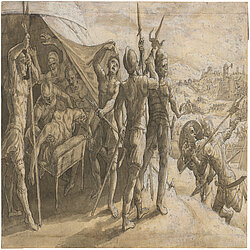Loading the page ...
Master of the Liechtenstein Adoration
active in the Southern Netherlands (?), circa 1550
This mysterious and gifted master has long eluded identification. The notname Master of the Liechtenstein Adoration was first introduced by Friedrich Winkler in 1963 when he was reviewing a group of sixteenth-century drawings with biblical scenes, most of which belonged to the collection of the Princes of Liechtenstein in Vaduz (and before that in Vienna) until they were sold in 1948. The drawings by this anonymous artist, numbering around twenty in all, have now been dispersed over several collections. The majority are executed in pen and black ink with white heightening on paper in opaque colours. Virtually all the works by the artist are executed in the same distinctive, easily recognizable style with figures in highly expressive poses and bold foreshortening. Furthermore, his compositions often have a compelling perspective with an effective use of chiaroscuro that is comparable to works by artists active in the Southern Netherlands such as Pieter Coecke van Aelst, although there is also an affinity with the South German Danube School.
Archive
